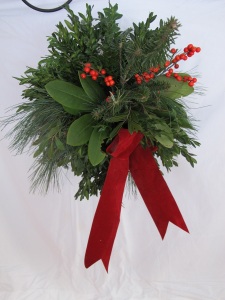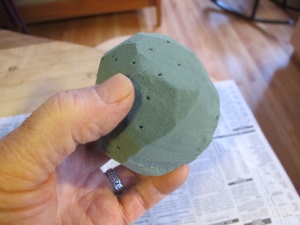Kissing Balls
At this time of year I need all the help I can get. Cloudy gray days do not make me cheerful. Days that end at 4pm do not please me. I counteract the dark with lights, flowers on the table, greenery (and maybe a little chocolate). This year I decided to make a kissing ball to hang from my chandelier in the living/dining area.
Kissing balls have a long history. During the Middle Ages villagers would hang balls of evergreens with a clay figure representing the Baby Jesus inside. Later, during the Victorian era, people would poke greens, particularly sweet-smelling greens, into apples or a potatoes and them and hang them in the house.
But they fell into disfavor, and mistletoe remained as the primary green hung in the house during much of the 1900’s. Mistletoe, of course allowed high-spirited youth to steal a kiss if a maiden was “accidentally” standing under the mistletoe. In this day of lawyers, no one wants to sell mistletoe because the berries are quite poisonous. But now decorated evergreen balls are back, being sold as kissing balls. I recently made one.
When I made my plans I didn’t think of an apple or a potato as the center of the ball. I bought a grapefruit and a large orange. But ultimately I decided I needed something longer lasting, and went to my local garden center to see if I could buy a ball of “Oasis”. Florists use Oasis to hold flowers and greens in place in arrangements while allowing them to absorb water. No one had balls of Oasis for sale, so I bought a 3 by 9-inch block.
I started the project by getting a variety of greens. I bought a small bundle of boxwood and cut branches of balsam fir, white pine, evergreen azalea and rhododendron.
Boxwood is loved by many gardeners: it is well behaved, slow-growing and has very small evergreen leaves that are a shiny green all year. They make great miniature hedges. I have avoided it because in the old days it was marginally hardy here. Now we have varieties that sneer at temperatures of 25 below and colder. Korean boxwood varieties such as Green Gem, Green Velvet and Green Mountain shouldn’t suffer winter burn or winter kill.
Oasis is very easy to cut. I used a long serrated bread knife, but you could use any knife. I soaked the sphere in water for 15 minutes or so, rotating it a few times and holding it under water so the entire thing would be well soaked. Then I took an old fashioned wire coat hanger and cut out a section. I kept the top hook portion, one angled side and the bottom wire. I straightened it out with a pair of needle nose pliers, and pushed it through the globe. I then twisted the bottom inch of wire to a right angle, and slipped a big fender washer on it to help support the sphere once I hung it, and to keep the delicate Oasis from being damaged by the wire.
I hung the ball from my chandelier and began the easy part: decorating it. I cut pieces of greenery into roughly 6-inch pieces, and gently poked them into the Oasis. I started at the top, creating concentric circles of white pine, then boxwood, balsam fir, another layer of boxwood, then azalea and rhododendron, and finally finishing up with more boxwood. Once I passed the “equator” I turned the leaves so that the shiny side would be facing down.
I used my pocket knife to shave off needles of the fir (which did not pull off easily), and to remove any lumps in the stems. On thicker branches, I shaved of a little wood to make a thinner branch to poke into the Oasis.
At the very bottom I attached a bow made of red ribbon, wiring it onto the hook at bottom after removing the washer. That insured that the wire would not pull though the Oasis, which is very delicate.
It was gorgeous. A globe of green with a nice variety of textures and colors of green. All it needed was some red berries. So my dog Daphne and I jumped in the car and drove to the nearest swamp. I had put on my tall boots, just in case some wading was required. Little did I know.
Our native holly, which loses its leaves, is called winterberry (Ilex verticillata). In the wild it lives in swamps, but is also a good landscape plant with loads of bright red berries. It is dioecious, meaning it has male and female plants; if you want berries, buy a male to go with your females (one male can service several females).
I cut some branches for my kissing ball and was leaving the swamp when, with a crack, I fell through the ice and water filled my boots. If I’d been captured on camera I might have started a new trend –icy water in boots instead of a bucket of ice water on the head. I laughed. Later, I poked stems of red berries into the kissing ball. It certainly brightens up the room, and I grin when I remember getting those red berries.
Henry Homeyer lives in Cornish Flat, NH. His books are available from his web site, www.Gardening-Guy.com. Contact him at henry.homeyer@comcast.net or P.O. Box 364, Cornish Flat, NH 03746.




